Managing accounts receivable (AR) effectively is crucial for maintaining the financial health of any business, especially in healthcare. With a steady influx of invoices and claims to process, ensuring timely payment becomes an ongoing challenge for medical practices and billing companies like Medlife MBS. Poor AR management can lead to delayed payments, cash flow problems, and even financial instability. So, how can healthcare providers and billing professionals handle their accounts receivable efficiently? In this blog, we’ll walk through actionable strategies to improve your AR management and streamline your revenue cycle.
1. Implement Clear Payment Terms
Setting clear payment terms upfront is the first step to effective AR management. Whether you’re dealing with insurance companies or patients, it’s essential that everyone understands your payment policies from the beginning. Patients should know what their co-payments, deductibles, or out-of-pocket expenses will be, and insurance companies should be aware of the terms for reimbursement.
Clearly outline payment deadlines, late fees, and any interest charges in your initial agreement. Well-defined payment terms will reduce confusion and help ensure that you receive payments on time.
2. Use Automation to Streamline the Process
Manual AR management can be time-consuming and prone to errors. That’s where automation comes in. Leveraging medical billing software with AR tracking capabilities can significantly reduce the administrative burden. These tools can automatically generate invoices, track payment statuses, and send out reminders to patients or insurance companies for outstanding balances.
Automation also helps with claim submission, making it easier to follow up with insurers if there are any delays or denials. By automating as many aspects of the AR process as possible, you not only save time but also improve accuracy and efficiency.
3. Regularly Review Aging Reports
Aging reports, which track how long invoices have been outstanding, are a key tool in managing accounts receivable. By reviewing aging reports frequently, you can identify accounts that are overdue and take appropriate action. Prioritizing older accounts for follow-up can help you recover payments before they become uncollectible.
Typically, aging reports categorize receivables by the number of days they’ve been overdue (e.g., 30 days, 60 days, 90 days, etc.). By focusing on the oldest accounts, you can address potential payment problems early and minimize bad debt.
4. Follow Up Consistently
Consistent follow-up is a fundamental part of AR management. The longer you wait to address overdue invoices, the harder it becomes to collect them. Establish a routine for following up on unpaid bills, whether through phone calls, emails, or mailed reminders.
For example, you might follow up with an email reminder after 30 days, a phone call after 60 days, and escalate the issue to collections after 90 days. The key is to maintain regular contact without waiting too long between reminders.
5. Offer Flexible Payment Options
Offering flexible payment options can encourage faster payments and make it easier for patients to settle their bills. For example, providing options for online payments, installment plans, or credit card payments can reduce friction and improve cash flow.
By giving patients more ways to pay, you increase the likelihood of receiving payments on time. This flexibility also helps build trust with patients, improving their overall experience with your practice.
6. Monitor Key AR Metrics
Keeping track of key AR metrics allows you to assess the effectiveness of your current process and make data-driven improvements. Some important metrics to monitor include:
- Days Sales Outstanding (DSO): This measures the average number of days it takes to collect payment. A lower DSO means you’re collecting payments more quickly.
- Percentage of Overdue Accounts: This tracks how many of your invoices are overdue and by how much time. A high percentage of overdue accounts can signal inefficiencies in your AR process.
- Bad Debt Ratio: This metric helps you determine the portion of your AR that has been written off as uncollectible. Keeping this number low is essential for maintaining financial health.
Regularly monitoring these metrics allows you to spot potential problems early and adjust your AR strategy accordingly.
7. Maintain Good Communication with Insurance Companies
In healthcare, a significant portion of accounts receivable comes from insurance claims. Therefore, maintaining good relationships with insurance companies is crucial. Clear communication can help you resolve issues quickly, whether it’s about claim denials, missing information, or delayed payments.
Building strong connections with your insurance providers can also help streamline the payment process. Regularly checking on claim statuses and following up on unpaid claims ensures that you’re keeping the revenue cycle moving smoothly.
The Benefits of Effective AR Management
Now that we’ve covered the core strategies for managing accounts receivable, let’s look at the benefits. When implemented effectively, AR management can:
- Improve cash flow: Timely payments mean you have more cash on hand to reinvest in your business or practice.
- Reduce bad debt: Proactively managing aging accounts reduces the number of unpaid invoices that need to be written off.
- Streamline operations: Automation and clear payment terms help minimize administrative burdens, allowing your staff to focus on other essential tasks.
- Enhance patient relationships: Offering flexible payment options and maintaining open communication builds trust and can improve patient satisfaction.
Ultimately, effective AR management ensures the financial stability of your practice or business, allowing you to focus more on providing quality services and less on chasing unpaid invoices.
Conclusion
Accounts receivable management is essential for maintaining a healthy revenue cycle in healthcare. By implementing clear payment terms, automating processes, regularly reviewing aging reports, and offering flexible payment options. Contact Medlife Mbs, we can ensure timely payments and improve their overall financial health. Monitoring key AR metrics and maintaining good relationships with insurance companies are also critical steps in keeping the AR process efficient.
Effective AR management not only stabilizes cash flow but also reduces the risk of bad debt, ultimately leading to better business performance.

